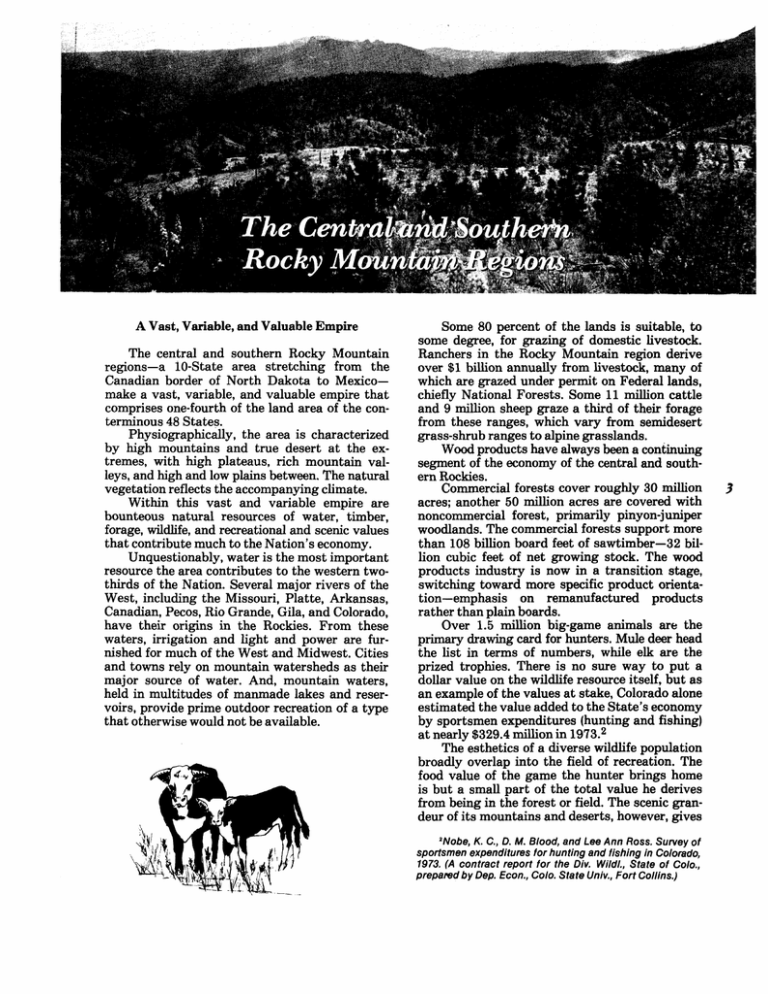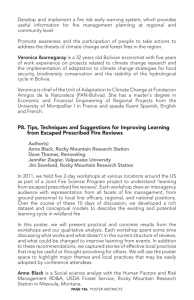A Vast, Variable, and Valuable Empire
advertisement

A Vast, Variable, and Valuable Empire The central and southern Rocky Mountain regions-a 10-State area stretching from the Canadian border of North Dakota to Mexicomake a vast, variable, and valuable empire that comprises one-fourth of the land area of the conterminous 48 States. Physiographically, the area is characterized by high mountains and true desert at the extremes, with high plateaus, rich mountain valleys, and high and low plains between. The natural vegetation reflects the accompanying climate. Within this vast and variable empire are bounteous natural resources of water, timber, forage, wildlife, and recreational and scenic values that contribute much to the Nation's economy. Unquestionably, water is the most important resource the area contributes to the western twothirds of the Nation. Several major rivers of the West, including the Missouri, Platte, Arkansas, Canadian, Pecos, Rio Grande, Gila, and Colorado, have their origins in the Rockies. From these waters, irrigation and light and power are furnished for much of the West and Midwest. Cities and towns rely on mountain watersheds as their major source of water. And, mountain waters, held in multitudes of manmade lakes and reservoirs, provide prime outdoor recreation of a type that otherwise would not be available. Some 80 percent of the lands is suitable, to some degree, for grazing of domestic livestock. Ranchers in the Rocky Mountain region derive over $1 billion annually from livestock, many of which are grazed under permit on Federal lands, chiefly National Forests. Some 11 million cattle and 9 million sheep graze a third of their forage from these ranges, which vary from semidesert grass-shrub ranges to alpine grasslands. Wood products have always been a continuing segment of the economy of the central and southern Rockies. Commercial forests cover roughly 30 million acres; another 50 million acres are covered with noncommercial forest, primarily pinyon-juniper woodlands. The commercial forests support more than 108 billion board feet of sawtimber-32 billion cubic feet of net growing stock. The wood products industry is now in a transition stage, switching toward more specific product orientation-emphasis on remanufactured products rather than plain boards. Over 1.5 million big-game animals are the primary drawing card for hunters. Mule deer head the list in terms of numbers, while elk are the prized trophies. There is no sure way to put a dollar value on the wildlife resource itself, but as an example of the values at stake, Colorado alone estimated the value added to the State's economy by sportsmen expenditures (hunting and fishing) at nearly $329.4 million in 1973.~ The esthetics of a diverse wildlife population broadly overlap into the field of recreation. The food value of the game the hunter brings home is but a small part of the total value he derives from being in the forest or field. The scenic grandeur of its mountains and deserts, however, gives 2Nobe,K. C., D. M. Blood, and Lee Ann Ross. Survey of sportsmen expenditures for hunting and fishing in Colorado, 1973. (A contract report for the Div. Wildl., State of Colo., prepared by Dep. Econ., Colo. State Univ., Fort Collins.) 3 MAJOR RIVER DRAINAGES AND GENERAL VEGETATION TYPES Rocky Mountain Forest and Range Experiment Station March 1976 SCALE - 200 O IN MILES growing youngster in d e u e w n g country . the area great interest to recreationists. National Forests within the area accounted for 18 percent of the visits or days' use for all the National Forests across the country in 1974, yet the area supports only 7 percent of the country's population. Winter sports, especially, are gaining rapidly in popularity. Recreation takes many forms in the central and southern Rocky Mountains, and encompasses all seasons. Regions Used Early Although the 10 States that make up the central and southern Rocky Mountain regions are officially young-7 are among the last 14 admitted to the Union-their history of use by the white man is old. Spanish explorers and settlers spread northwestward from Mexico over much of the region before the Pilgrims landed in New England. Early records show that a Jesuit missionary promoted livestock raising in southern Arizona in 1540. The Spanish settlers spread mostly over the lowlands, following the river courses back into the interior. Settlement of the rugged, mountainous areas, and the prairies to the east, progressed slowly until the late 1880's. Then several factors combined to cause boom growth: the construction of railroads to link East and West, the discovery of rich ores of gold and silver, and trail herds of cattle moving east from the Oregon Territory to Nebraska and Kansas railheads were a few. Significantly, the lack of water-or perhaps more accurately, the erratic distribution of water -was a challenge even then to the development of communities and agriculture. 'Extensive irrigation systems were functioning as early as 1880. Forests, especially those around developing communities, were logged off to provide necessary fuel, building lumber, fence and corral posts, mine timbers, and railroad ties. The tie hacks, especially, high-graded the forests in the railroaders' rush to connect the Coasts. Railroad construction also adversely affected the wildlife. Market hunters slaughtered great herds of game to provide meat for construction crews. The range resource, too, was hit hard before the human population increased significantly. Livestock numbers soared to an early peak in 1885-over 5 million head of cattle, and nearly 10 million head of sheep. Overgrazing soon took its toll, and the herds suffered heavy losses during droughts and blizzards. A Great Public Resource Large segments of the forest and rangelands in the central and southern Rocky Mountain regions are in public ownership and-significantly -a public responsibility. Moreover, a close mountain-valley relationship exists. What happens on or to the mountains directly affects the values and activities in the adjacent valleys and cities. Here lies an immense piece of highly valuable real estate, its potential yields of renewable natural resources not yet fully known or appraised in terms of management guides. The dominant value of the water resource requires that management and use of the other resources must often consider water yield as a limiting parameter. Thus, the economics of multiple-use relationships play an increasingly important role in the great Rocky Mountain empire. A close nuncntuin-valley rekationship exists i n the central and southern Rocky Mountuin regions.





